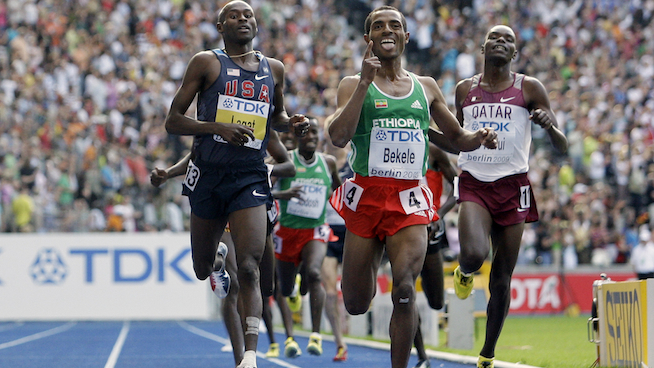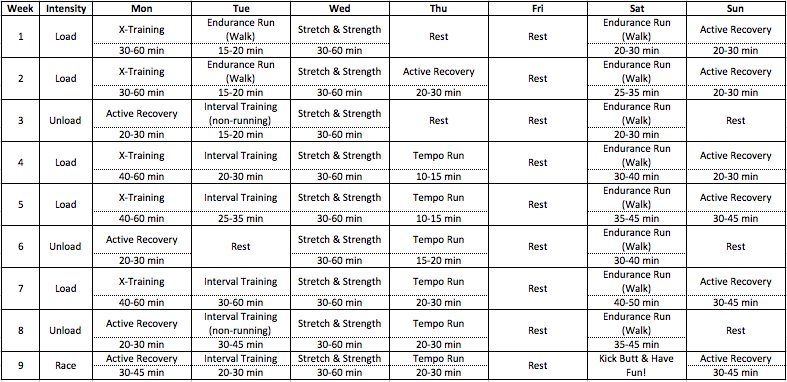5 Keys and A Workout Plan for An Awesome 5K

AP Images
All athletes can benefit from a structured, tailored training program. If your goal is to finish your first 5K or run your next one faster than your last, follow these five keys and use the day-by-day workout plan for the eight weeks leading up to your race.
Variety
Varying the type, intensity and duration of your workouts is essential for reducing injury risk. The biggest mistake beginners make is running at the same pace for the same amount of time three to four days per week.
Progression
To stay healthy throughout your training program, find the proper balance of stress and rest. You must challenge yourself, but you also need to listen to your body and take regular, planned physical and mental breaks. Progressively build your intensity and duration.
Consistency
You benefit more from shortening a workout on a planned day than from skipping it entirely and doubling up the next day. Online software programs, smart phone apps, an Excel spreadsheet, or a pencil and calendar are all excellent tools for recording your accomplishments along the way.
Awareness
Walking, jogging and running help you become more in tune with your body. Exercise features some Zen characteristics. Work out in different environments, experiment with nutrition plans and try not listen to music unless you are working indoors. Running does suck at times, but the overall experience of a 5K training program can—and should be—awesome!
Enjoyment
Have fun with your workouts, your training and your race. Find a buddy or group to run with; misery loves company. Sign up for a themed 5K and wear a silly costume. Find a cross-training sport you enjoy. And most importantly, take time to reflect on your experiences as they happen.
5K Training Guide: Definitions
- Load: Involves some form of a build or increase in one or more of your workouts.
- Unload: Involves decreasing the intensity of workouts, resting an extra day, or replacing a challenging workout with active recovery.
- X-Training: Cross training, 30 to 90 minutes of an exercise, sport or activity other than running. If your legs feel up to it, sports that involve running (like soccer and basketball) count as cross training.
- Endurance Run (walk): Walking, jogging or running at a relatively comfortable pace—i.e., slightly slower than your goal race pace. If you do not have a goal race pace (you just want to finish), your endurance runs should be at a pace where you break a sweat but can still carry on a conversation.
- Stretch & Strength: 30 to 60 minutes of strength training and/or dynamic stretching. Boot camp-style classes are perfect for these workouts.
- Active Recovery: A 20 to 60 minute light exercise routine—e.g., low-intensity cardio (such as spinning), stretching, foam rolling, Pilates, yoga and non-impact sports.
- Interval Training: A 20- to 60-minute routine of alternating intensities (hard and easy). Intervals can apply to any form of cardio (including running). Start with a 2:1 ratio of easy-to-hard, progress to a 1:1 ratio, and eventually to a 1:2 ratio.
- Tempo Run: Jogging or running at a mildly uncomfortable pace—i.e., at, or slightly faster than, your goal race pace. You should break a sweat and elevate your heart rate to the point where you can still speak to someone, but not carry on a full conversation. These runs are typically shorter than your goal race distance (e.g., 1 to 2.5 miles for a 5K workout program).
5K Training Guide: Descriptions

Read More:
[cf]skyword_tracking_tag[/cf]RECOMMENDED FOR YOU
MOST POPULAR
5 Keys and A Workout Plan for An Awesome 5K

AP Images
All athletes can benefit from a structured, tailored training program. If your goal is to finish your first 5K or run your next one faster than your last, follow these five keys and use the day-by-day workout plan for the eight weeks leading up to your race.
Variety
Varying the type, intensity and duration of your workouts is essential for reducing injury risk. The biggest mistake beginners make is running at the same pace for the same amount of time three to four days per week.
Progression
To stay healthy throughout your training program, find the proper balance of stress and rest. You must challenge yourself, but you also need to listen to your body and take regular, planned physical and mental breaks. Progressively build your intensity and duration.
Consistency
You benefit more from shortening a workout on a planned day than from skipping it entirely and doubling up the next day. Online software programs, smart phone apps, an Excel spreadsheet, or a pencil and calendar are all excellent tools for recording your accomplishments along the way.
Awareness
Walking, jogging and running help you become more in tune with your body. Exercise features some Zen characteristics. Work out in different environments, experiment with nutrition plans and try not listen to music unless you are working indoors. Running does suck at times, but the overall experience of a 5K training program can—and should be—awesome!
Enjoyment
Have fun with your workouts, your training and your race. Find a buddy or group to run with; misery loves company. Sign up for a themed 5K and wear a silly costume. Find a cross-training sport you enjoy. And most importantly, take time to reflect on your experiences as they happen.
5K Training Guide: Definitions
- Load: Involves some form of a build or increase in one or more of your workouts.
- Unload: Involves decreasing the intensity of workouts, resting an extra day, or replacing a challenging workout with active recovery.
- X-Training: Cross training, 30 to 90 minutes of an exercise, sport or activity other than running. If your legs feel up to it, sports that involve running (like soccer and basketball) count as cross training.
- Endurance Run (walk): Walking, jogging or running at a relatively comfortable pace—i.e., slightly slower than your goal race pace. If you do not have a goal race pace (you just want to finish), your endurance runs should be at a pace where you break a sweat but can still carry on a conversation.
- Stretch & Strength: 30 to 60 minutes of strength training and/or dynamic stretching. Boot camp-style classes are perfect for these workouts.
- Active Recovery: A 20 to 60 minute light exercise routine—e.g., low-intensity cardio (such as spinning), stretching, foam rolling, Pilates, yoga and non-impact sports.
- Interval Training: A 20- to 60-minute routine of alternating intensities (hard and easy). Intervals can apply to any form of cardio (including running). Start with a 2:1 ratio of easy-to-hard, progress to a 1:1 ratio, and eventually to a 1:2 ratio.
- Tempo Run: Jogging or running at a mildly uncomfortable pace—i.e., at, or slightly faster than, your goal race pace. You should break a sweat and elevate your heart rate to the point where you can still speak to someone, but not carry on a full conversation. These runs are typically shorter than your goal race distance (e.g., 1 to 2.5 miles for a 5K workout program).
5K Training Guide: Descriptions

Read More:







